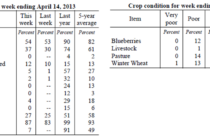👤Tom Allen, Extension Plant Pathologist
🕔15:32, 4.May 2013
Scattered reports of wheat diseases have been made over the past two weeks. Limited leaf rust, stripe rust, and Septoria leaf blotch can be observed in some wheat fields. In addition, in some situations bacterial leaf streak can be readily observed on flag leaves in some limited situations. In some cases, bacterial leaf streak and Septoria leaf blotch can appear similar to one another. In most cases, Septoria leaf blotch can be observed in the lower canopy and likely will not move up the plant to the flag leaf. However, bacterial leaf streak can be more readily observed on flag leaves in some fields.
Read Full Article▸



